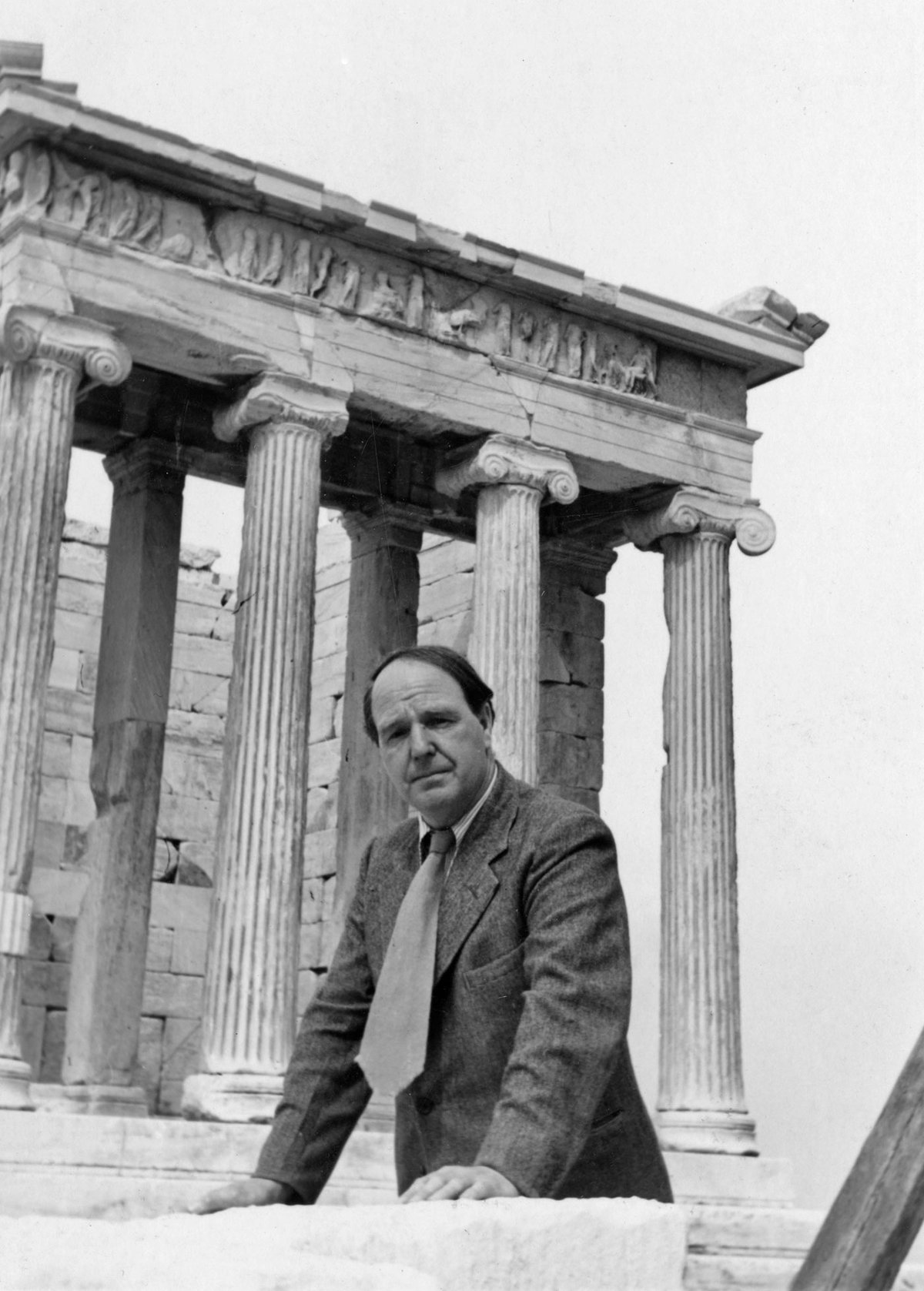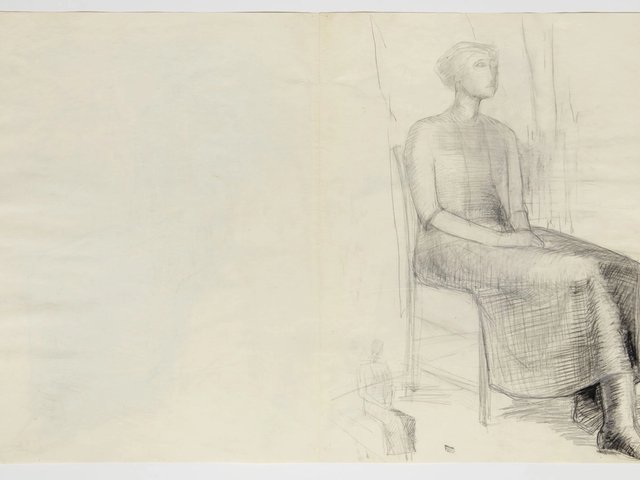A hundred years after the sculptor Henry Moore completed his studies at the Royal College of Art (RCA), in London, in 1924, and 47 years after Moore set up the foundation that bears his name, the Henry Moore Foundation has recently engaged in international loan exhibitions that examine the artist’s legacy and his global reception through the prisms of Ancient Greece and a fellow 20th-century game-changing artist, Georgia O’Keeffe.
Both exhibitions—Henry Moore and Greece, which was staged at Gagosian in Athens earlier this autumn, and Georgia O’Keeffe and Henry Moore, currently at the Museum of Fine Arts (MFA), Boston (until 20 January 2025)—demonstrate what the Henry Moore Foundation’s director, Godfrey Worsdale, refers to as Moore’s lifelong openness to new influences and materials. In setting Moore’s work against O’Keeffe’s, the exhibition at MFA Boston sheds light on their shared approach to abstracting nature from their own collections of found stones, seashells and other materials. It reveals the way animalian bones played into both artists’ worldviews.
The exhibition at Gagosian Athens, meanwhile, included pieces from the early 1950s, made soon after Moore’s first and only visit to mainland Greece in 1951. On this trip, he was inspired by the immemorial power of the Parthenon—as well as of archaeological sites at Delphi, Olympia, and Mycenae—and works on view in the show portray how his encounter with them influenced his continued exploration of the human figure. They also captured him beginning to resolve his experience of the First World War, the artist having served in France with the Civil Service Rifles and been gassed at the Battle of Cambrai in November 1917, before being sent home to England to convalesce.
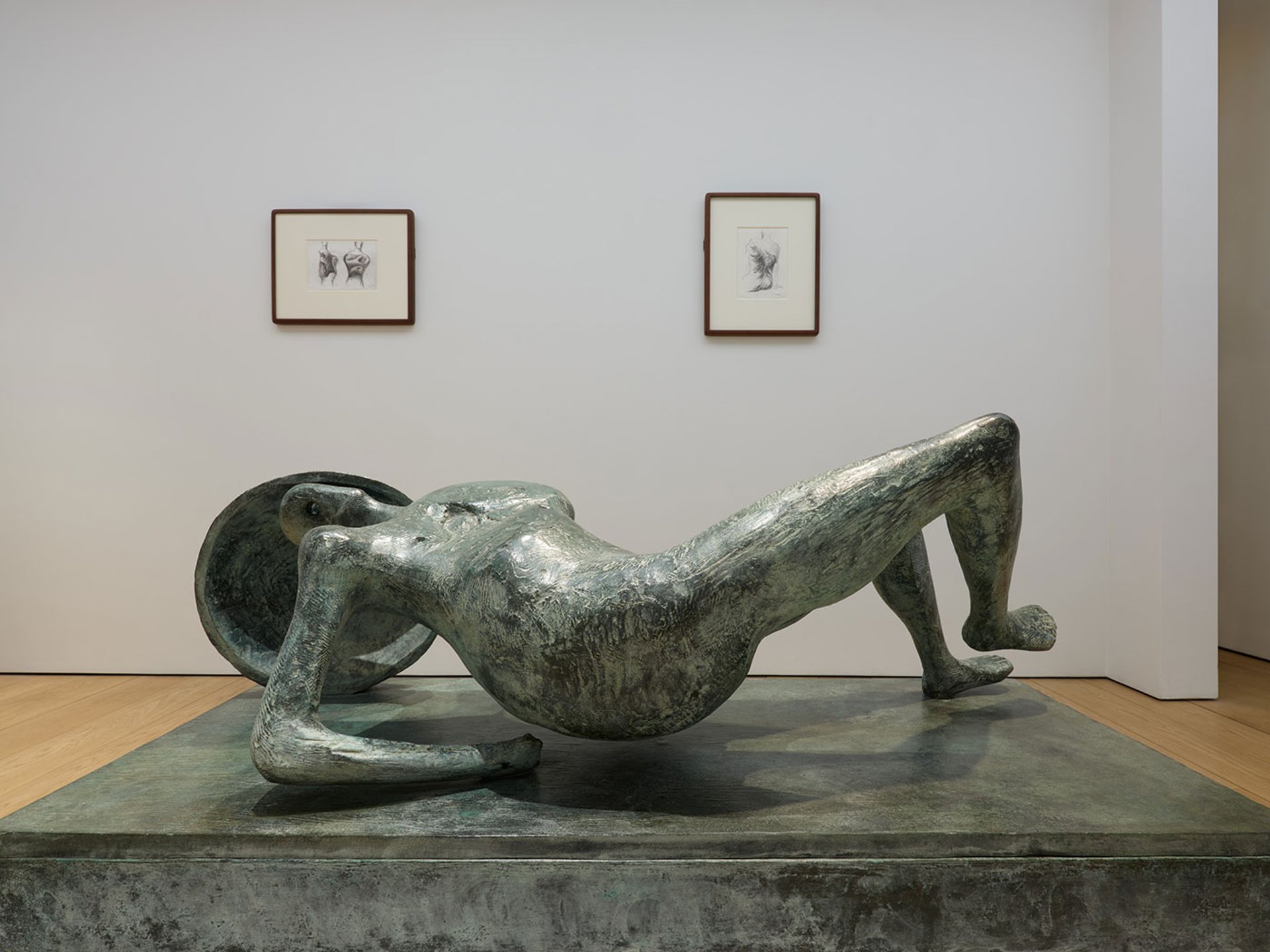
Henry Moore, Falling Warrior, 1956–57, on show at Henry Moore and Greece, Gagosian Athens, 2024 © The Henry Moore Foundation. Photo: Stathis Mamalakis. Courtesy Gagosian
Moore’s delay in publicly navigating the horror of his experience of this conflict—when only 200 of the 500 men in his battalion survived—was not untypical of artists of his generation, as Godfrey Worsdale, director of the Henry Moore Foundation, tells The Art Newspaper. (A parallel case is the artist and poet David Jones, a friend of Moore’s. Jones engaged with the harrowing experiences he had while serving with the London Welsh Battalion of the Royal Welch Fusiliers on the Western Front in 1915–1918 through his long-form poem In Parenthesis, published in 1937.)
Worsdale refers to Moore’s warrior and shield pieces of the 1950s—a bronze Falling Warrior (1956–57) was loaned to the Athens exhibition—as demonstrating “clear references to classical antiquity” in the years following Moore’s 1951 visit to Greece. “But there is also perhaps a moment where Moore feels he can begin to reflect on those difficult memories” of the First World War, he adds.
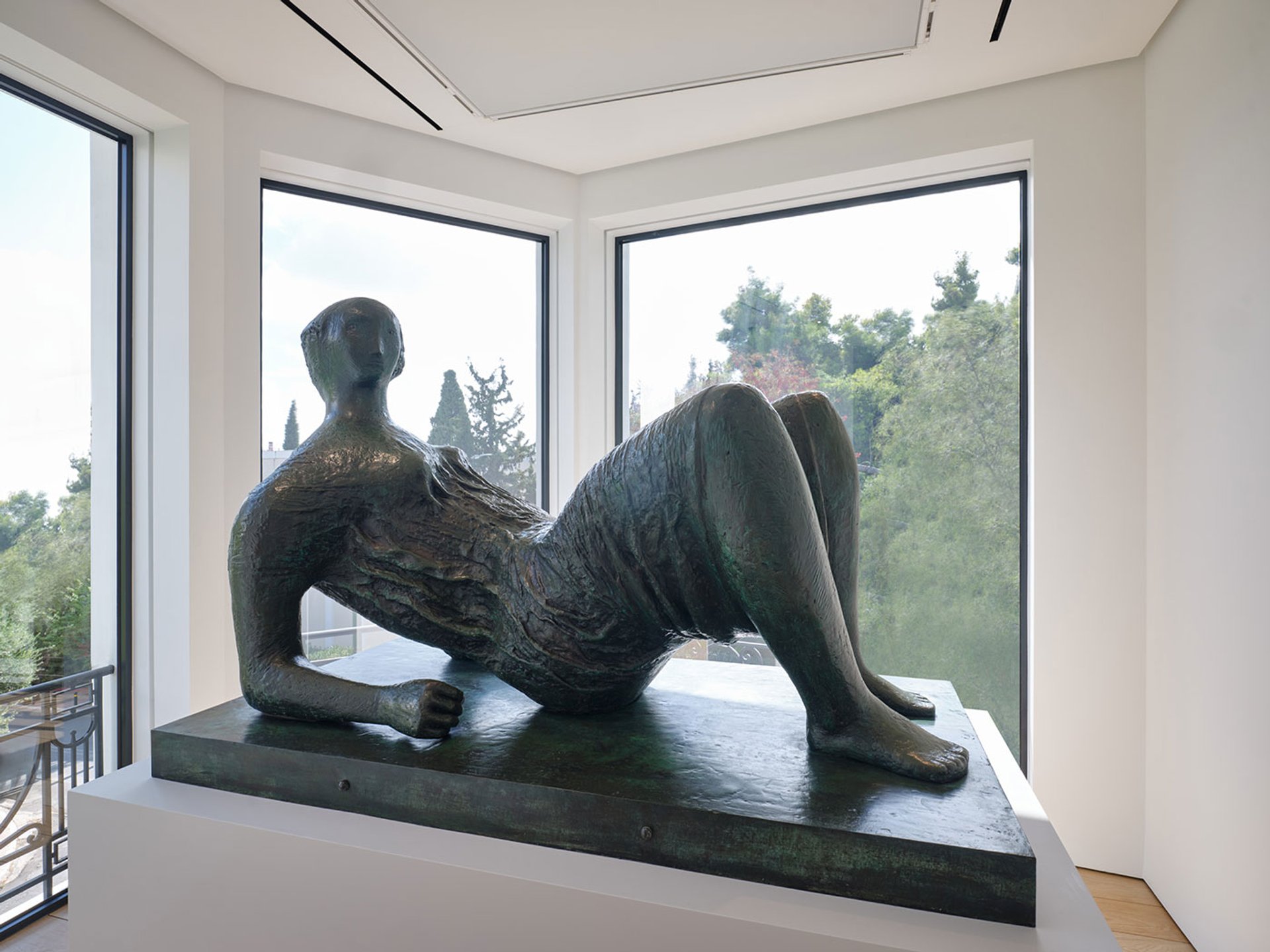
Henry Moore, Draped Reclining Figure, 1952–53, on show at Henry Moore and Greece, Gagosian Athens, 2024 © The Henry Moore Foundation. Photo: Stathis Mamalakis. Courtesy Gagosian
Worsdale also sees the depictions of warriors and shields as knitting together the various strands of Moore’s practice, in what was the halfway mark of the artist’s public career, 30 years after he had completed his studies at the RCA. “William Rothenstein, who'd taken over the Royal College when Moore arrived,was open to the trends of the avant garde and Moore felt the direct benefit of Rothenstein’s support,” Worsdale says. It was also a moment, he continues, where the British-American sculptor Jacob Epstein's interest in art of other cultures and earlier periods “was beginning to dominate. So Moore arrived at the right time, to be one of a number of artists who brought those conflicting educations together.”
Moore was inspired by Mesoamerican and African models in his work of the 1920s and 1930s, but was open to a change after encountering Greek art at source. “There is a shift in direction [following his visit to Athens in 1951],” Worsdale says, “most beautifully illustrated by a draped reclining figure”. This sculpture, Moore’s bronze Draped Reclining Figure, 1952–53, was included in the Athens show, and conveys Moore’s realisation that “a draped figure is in some respects more informative of the human form than a straightforward nude”. There was an openness, Worsdale says, “to find these subtleties and let them play out in the work”, and it was something that “really stayed with him most of his career".
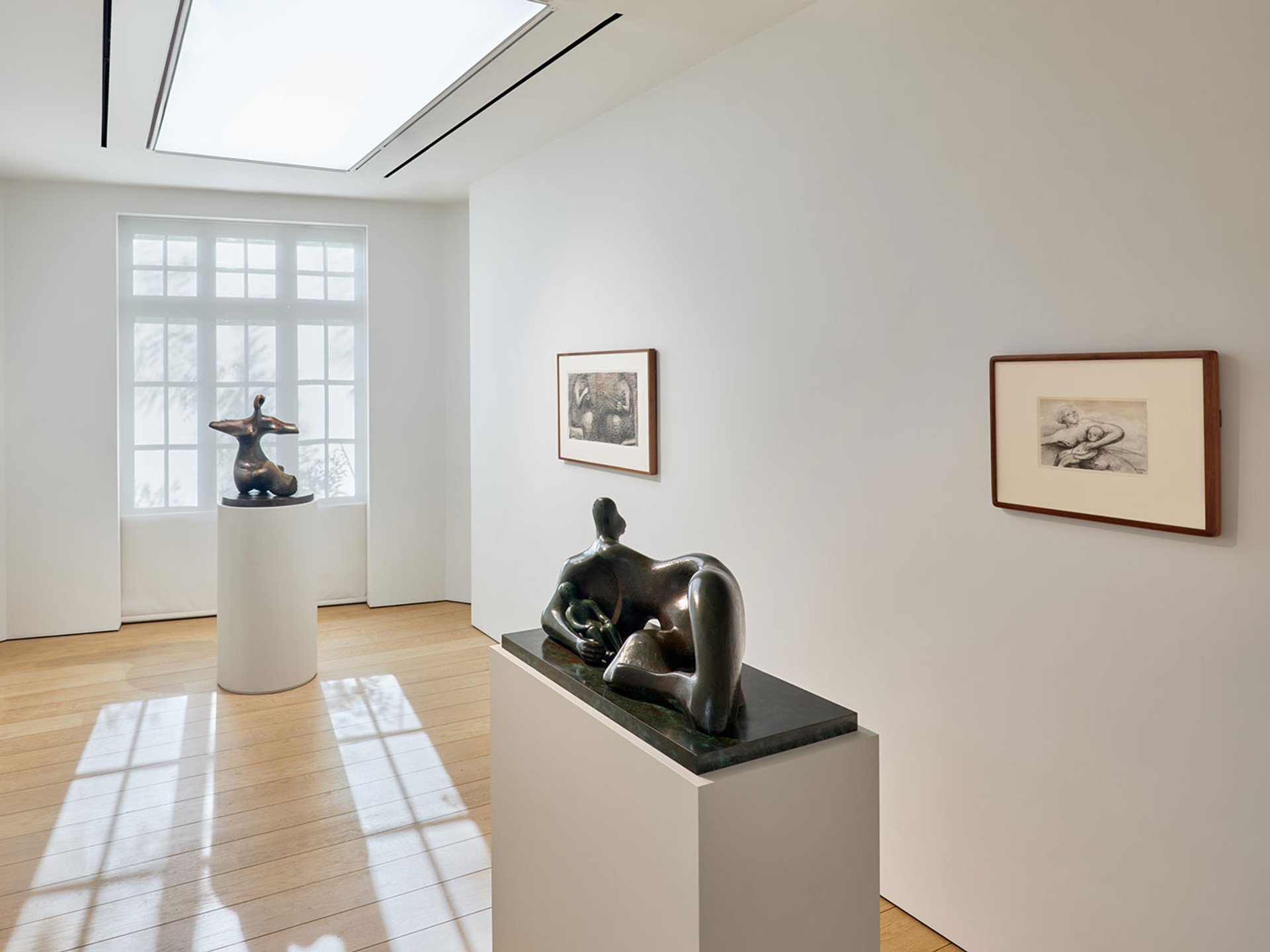
Installation view of Henry Moore and Greece at Gagosian Athens, 2024 © The Henry Moore Foundation. Photo: Stathis Mamalakis. Courtesy Gagosian
Worsdale was struck by how well Moore’s work looked in Athenian light during the Gagosian exhibition. The viewer could “straight away relate back to 1951 when Moore made his first visit to Greece. [He was] already a very knowledgeable historian of sculpture, and knew a great deal about Greek antiquity, but his two passions were the history of sculpture and natural light”. Experiencing the sites of antiquity in Greek light for the first time, Worsdale says, “was really a powerful experience” for Moore.
The exhibition included his Standing Figure: Knife Edge (1961), which was shown in the First International Exhibition of Sculpture held near the Acropolis, as part of the 1965 Athens Festival. The Gagosian show was the first of Moore’s work put on in the Greek capital since the 2004 Olympiad. “For people to be able to be in Athens, to be close to those historic sites,” Worsdale says, “and then to think about Henry Moore's reflections and references to that [was] at the very heart of this project.”
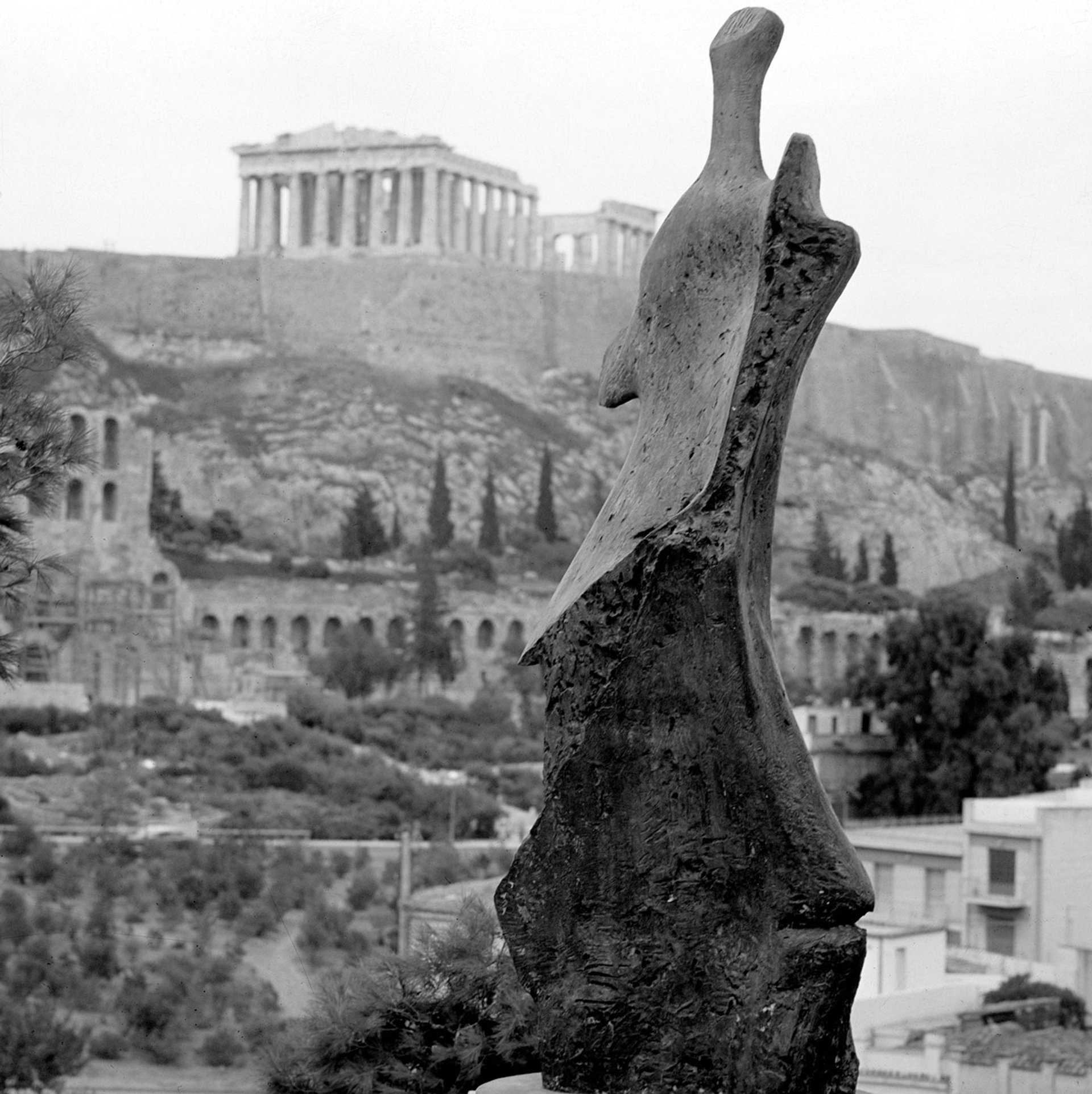
Henry Moore, Standing Figure: Knife Edge (1961) installed on Philopappos Hill opposite the Acropolis as part of the First International Exhibition of Sculpture, Athens Festival, 1965 © The Henry Moore Foundation. Photo: Henry Moore Archive. Courtesy The Henry Moore Foundation Archive
A carefully managed legacy
The Athens exhibition is also a reminder of what a full and productive life Moore led. The Henry Moore Foundation used the occasion of the show to release three previously unpublished prints from a cycle of seven lithographs. The foundation has a million items in its care, including photographs and diaries, and has catalogued more than 13,000 works by Moore. This astonishing mass of works were produced around a full social life, with Moore attending exhibition and theatre openings, serving on committees and as a trustee of both London’s Tate Gallery (as Tate was known then) and the capital’s National Gallery. Moore’s engagement diaries, held in the foundation’s archive at Moore's former home in Perry Green, Hertfordshire, reveal how he organised his Sundays—the day he received friends, artists and visiting dignitaries—with almost military precision.
The newly published prints are some of many held back in Moore’s lifetime for fear of flooding the market. Moore worked with the legendary Stanley Jones of Curwen Press, in London, with Swiss lithographers, and in his own studio, Worsdale says, to generate more than 719 editioned prints throughout his career and 74 portfolios from the 1930s to the 1980s.

Henry Moore, Man and Woman in Landscape, 1984, one of three previously unpublished prints from a cycle of seven lithographs and etchings released by the Henry Moore Foundation on the occasion of the 2024 Athens exhibition © The Henry Moore Foundation. Photo: Prudence Cuming Associates Ltd. Courtesy Gagosian
Moore the established international star
The Moore who visited Greece was, at 52, an established international star. His years as a war artist had seen him produce two books—Henry Moore. Sculpture and Drawings (1944), with an introduction by Herbert Read, and Shelter Sketch Book (around 1944)—that had secured his place as a household name and the leading British sculptor of his generation. He had a retrospective at the Museum of Modern Art (MoMA) in New York in 1946, and was celebrated in London in 1951 with a Sculpture and Drawings survey at the Tate Gallery, curated by the 27-year-old David Sylvester. He was also commissioned to make the bronze Reclining Figure: Festival (1951) for the Festival of Britain, the story of which was told by the film-maker John Read in a ground-breaking documentary for the BBC.
“Everyone knows Henry Moore as this great figure of 20th-century sculpture, but he was also a passionate scholar of the medium and, through that, had this sense of a continuum running through human creativity that linked the great moments in the history of sculpture together,” Worsdale says. “And I feel that for him, it was very important that people understood his work to be in dialogue with these moments of art history.”
Despite being a busy, global artist, Moore engaged closely in the work of others working at the time. In 1955 the artist Daphne Pollen—a star pupil at the Slade School of Art, London, in 1918-20, whose drawings and paintings are today in the collections of the National Portrait Gallery, Campion Hall, Oxford and Stonor Park, Oxfordshire—wrote, in her diary, of an instance where he showed personal critical interest in his friend David Jones’s retrospective exhibition at Tate Britain. (Pollen and her sculptor husband Arthur Pollen were long-standing friends of both “Harry” Moore and Jones.)
“D[avid Jones] was pleased,” Daphne Pollen writes in an entry from 25 January 1955, “when Harry Moore went round with him analysing his development in producing form & managing design, first in 2 dimensions & then in 3 & lastly weaving them all together—but even he misses the ‘many-splendoured’ thing…”
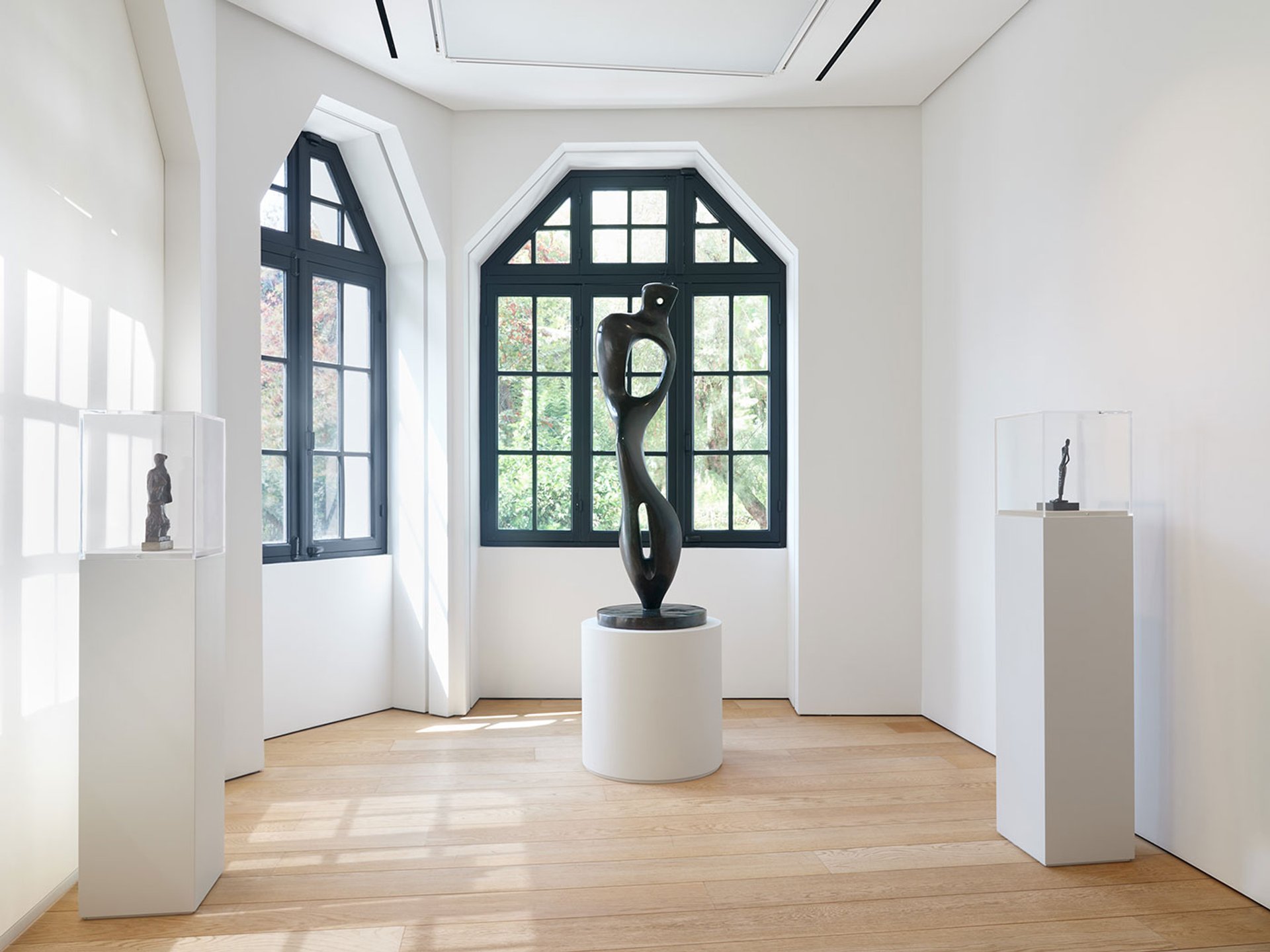
Installation view of Henry Moore and Greece, 2024Gagosian Athens © The Henry Moore Foundation. Photo: Stathis Mamalakis. Courtesy Gagosian
“Even he” is indicative of how Moore’s contemporaries admired his powers of analysis, challenged as he might have been by the fugitive poetry and allusive magic of Jones’s drawings. Many, like the Pollens, saw the extraordinary analytical certainty of Moore’s methods as one of the ways that he maintained his output as an artist, working on an ever-grander scale with bronze casts as public commissions poured in from around the world.
Worsdale sees that certainty in Moore’s lifetime of work but emphasises his all-encompassing openness to the varied artistic currents of his day. He reflects on Moore’s formative years in 1930s London when the “important end of the British art world was splitting between the Seven and Five Society, the abstractionists and the surrealists. And they were manifesto-driven and committee-guided and everything. Somehow—and this speaks volumes about his kind of personality and his disposition—Moore was warmly welcomed and belonged in both camps.”
Henry Moore Foundation plans for 2025
That all-encompassing Moore will be celebrated next year, as part of the Henry Moore Foundation’s plans—for the Henry Moore Institute in Leeds, and the Henry Moore Studios and Gardens at Perry Green, in Hertfordshire—announced this week. Encounters, at Perry Green, will consist of a series of events held between April and October that “celebrate the inspiring and transformative encounters between Henry Moore and the people, objects and ideas in his orbit during his active career and beyond”, according to a statement from the foundation.
The Encounters programme will conclude with an international conference on the artist in autumn 2025, while the foundation plans to capture “the array of voices and perspectives from those who encountered and worked alongside Moore” in a permanent exhibition that is due to open in a renovated Sheep Field Barn at Perry Green in 2026.
In Leeds, the institute will show works by numerous contemporary artists, including Tacita Dean, Anya Gallaccio, Andy Goldsworthy, John Hilliard and David Nash in Passing Strange: British Land Art Through Time. The show will address an “alternative vision of land art” to that of the US pioneers Robert Smithson and Michael Heizer. It is also a reminder of Moore as a maker of public art, including for new towns in postwar Britain, for Scottish moorland and, on an ever-grander scale, for plazas and squares around the globe from the late 1950s to his death in 1986.
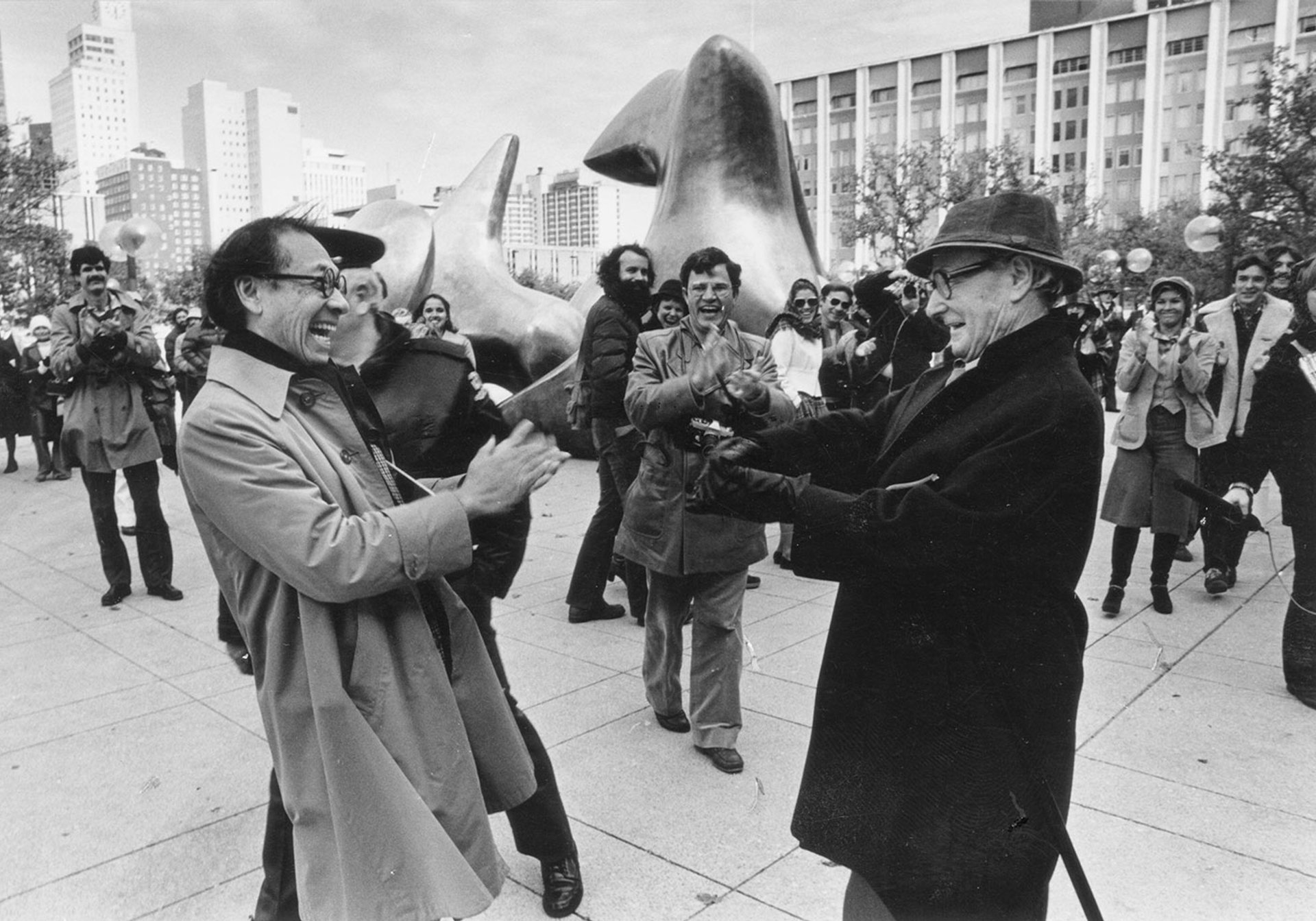
The architect I.M. Pei (left) and Henry Moore applaud each other at the inauguration of Moore's Three Forms: Vertebrae, Dallas, May 1978. The sculpture stands in front of Pei's Dallas City Hall (out of picture left), which was completed in the same year
Photo: Henry Moore Archive
In May 1978, Moore and the visionary architect IM Pei—the first full survey of whose work is at M+ in Hong Kong until January 2025—were photographed together at the inauguration of Moore’s Three Forms: Vertebrae in the central plaza in Dallas, Texas. (The Dallas project was one of five that Moore worked on with Pei, with others including a large version of his Mirror Knife Edge for the new East Wing the architect built for the National Gallery of Art in Washington, DC, also unveiled in 1978.) In the photograph, Pei and Moore face each other, swaying back almost in imitation of Pei’s new inverted-pyramid Dallas City Hall; each is amused, smiling ear to ear, applauding the other, as they appear instinctively to choreograph an embrace. It is an image that captures Moore the master of public art, who in the six decades of concentrated work following his graduation, remained the inquisitive, interdisciplinary practitioner; an art-world diplomat who had absorbed multiple "conflicting educations" in his youth and was open—whether in 1930s London, 1951 Athens or 1970s Dallas—to outside influence, to the pull of experimentation, exploration and creative collaboration.
It is that openness, to use Worsdale’s words, that allowed Moore's work to “refresh almost decade by decade, sometimes by taking a step back into things he knows well, and sometimes reflecting on what's happening in the world around him”.
- Georgia O’Keeffe and Henry Moore, Museum of Fine Arts, Boston, until 20 January


